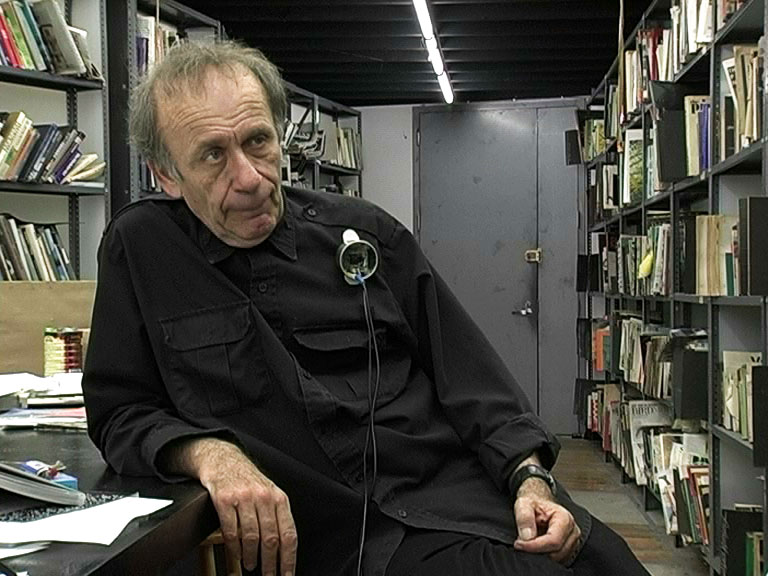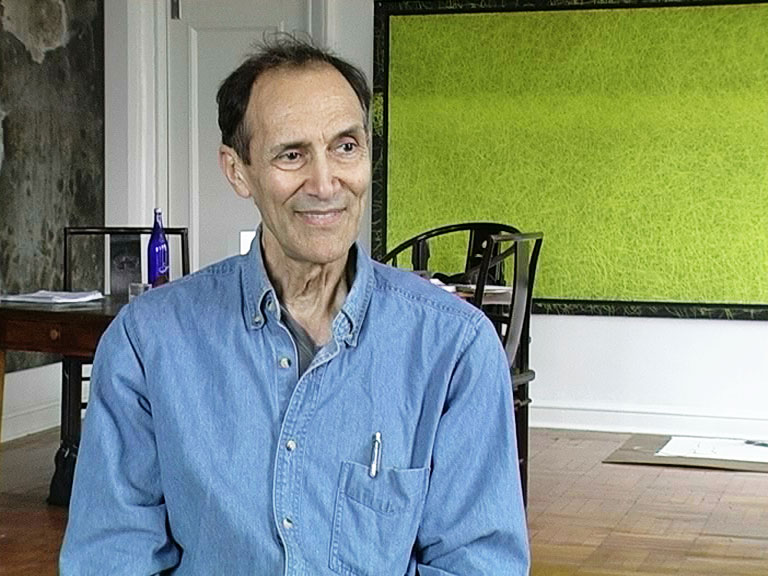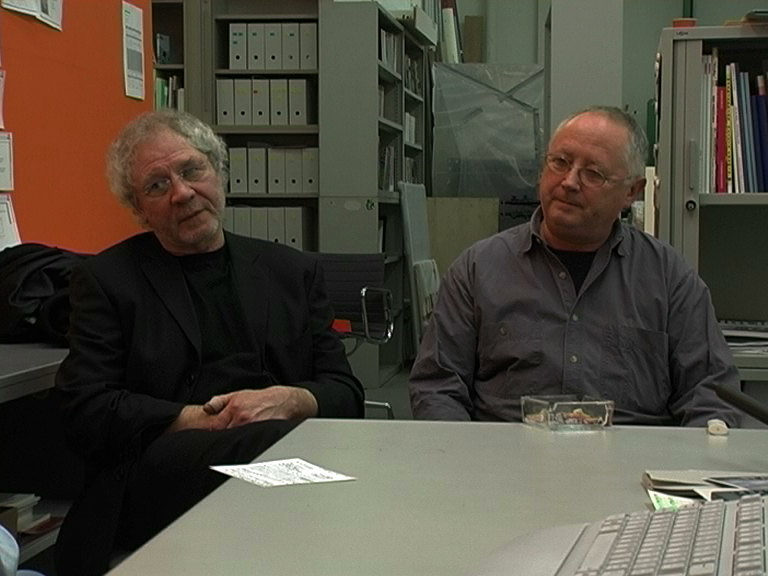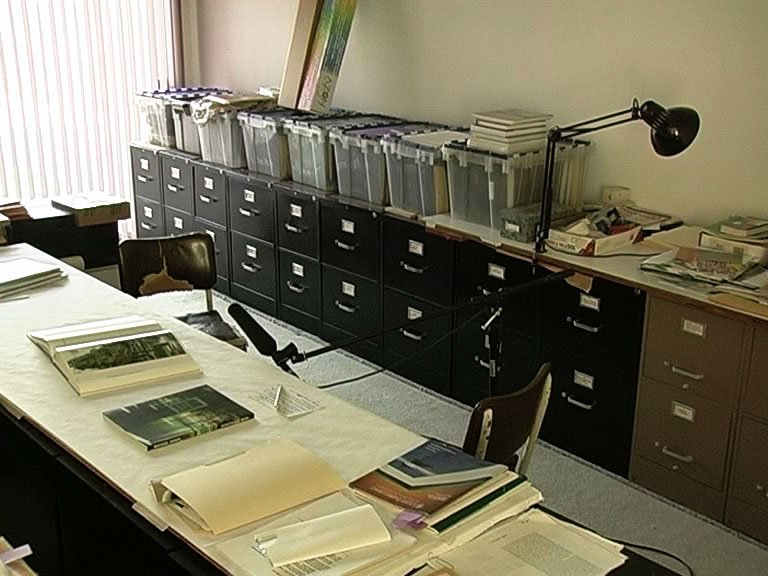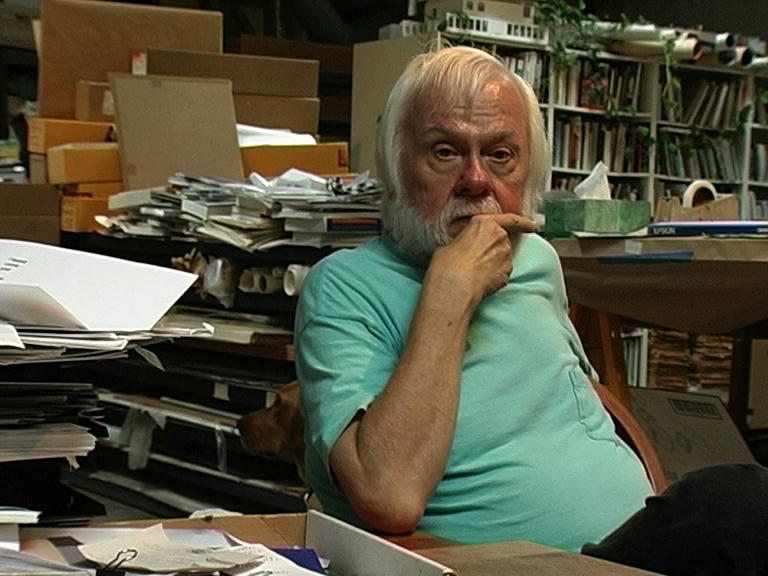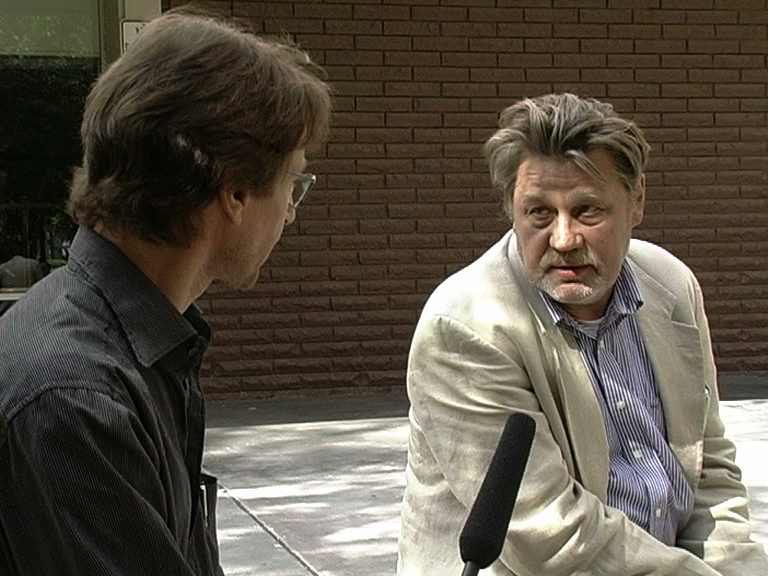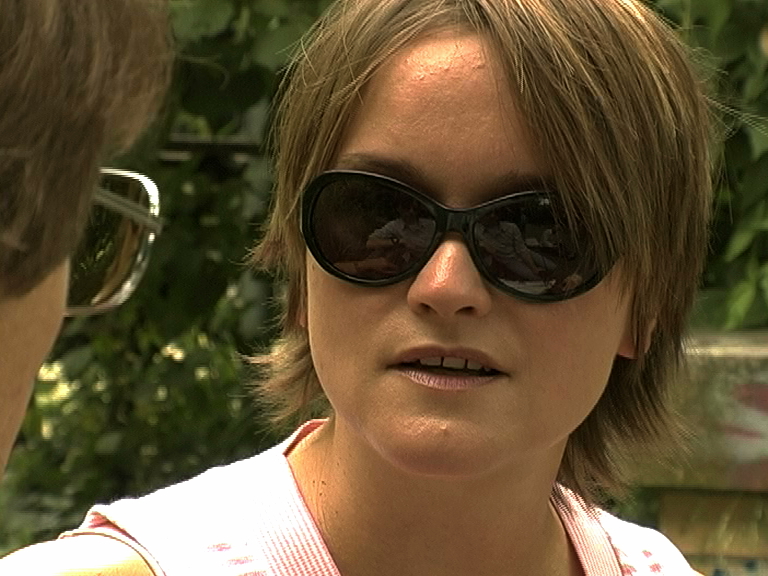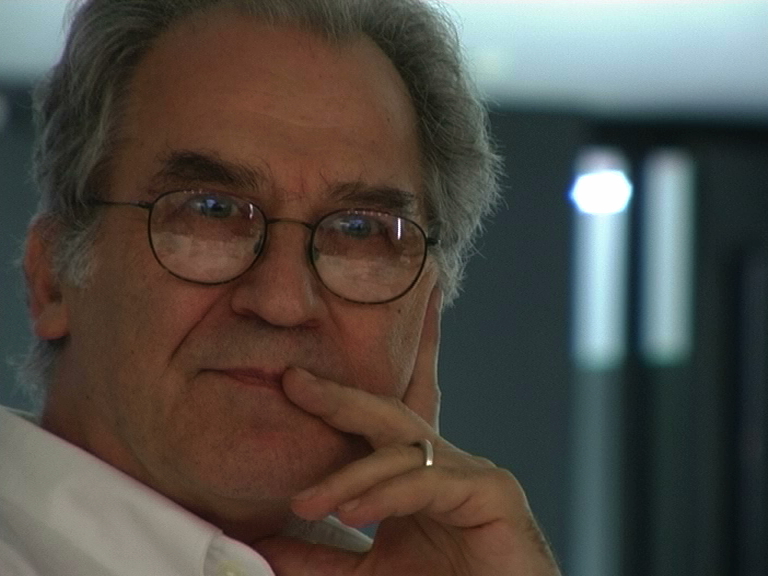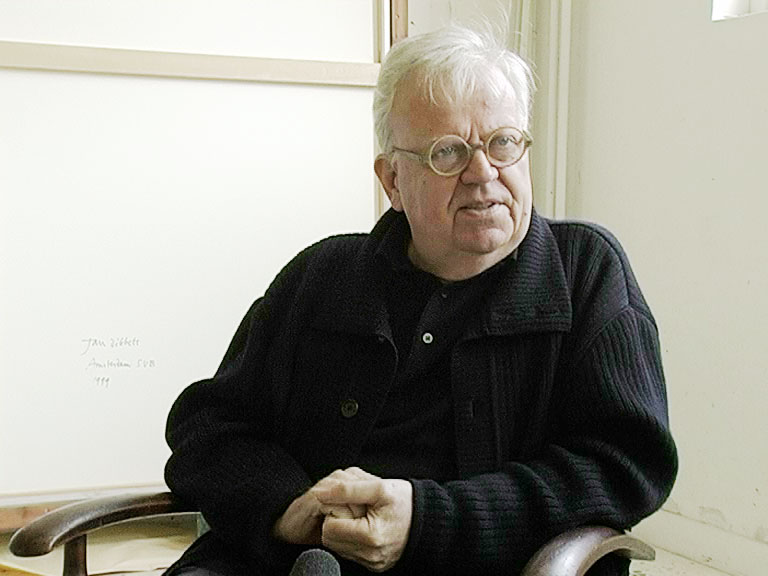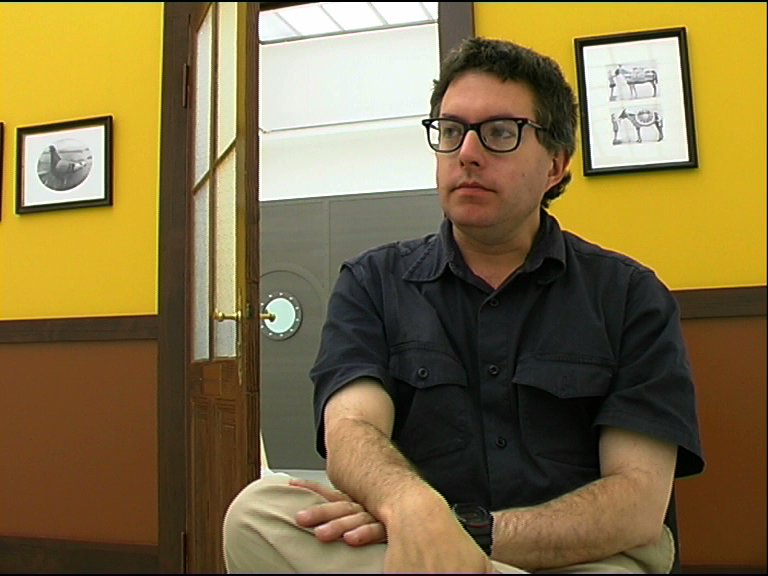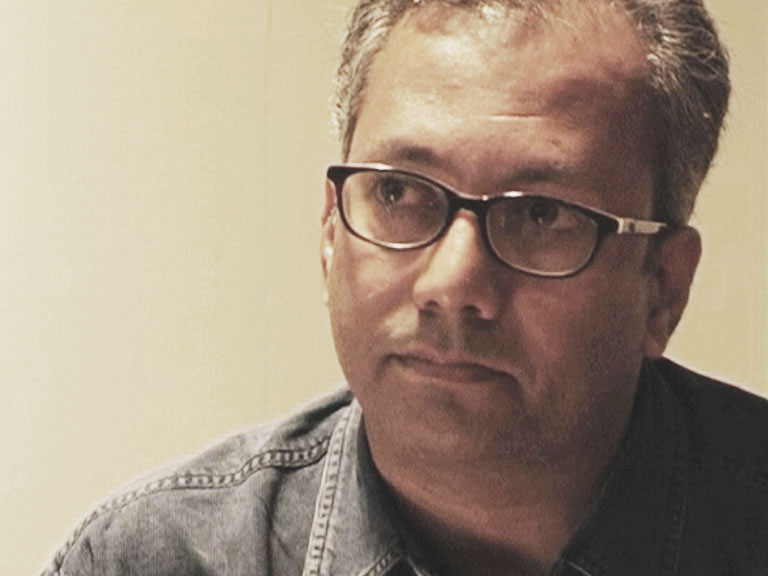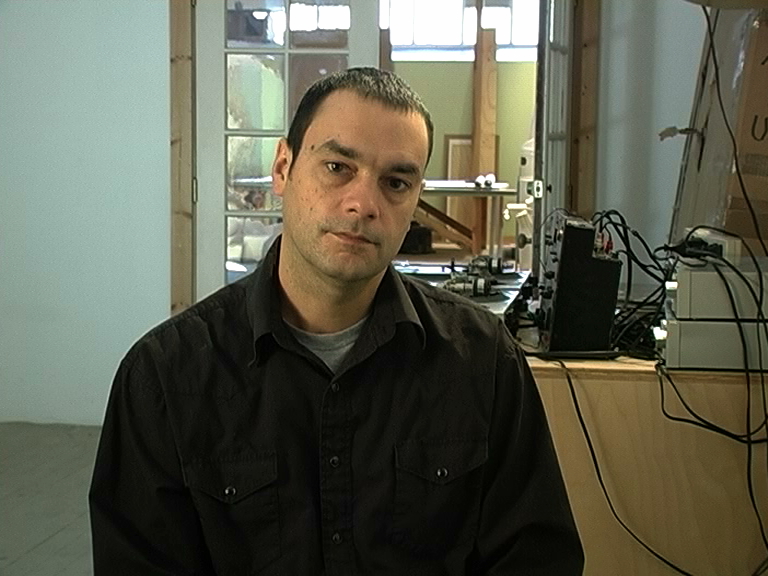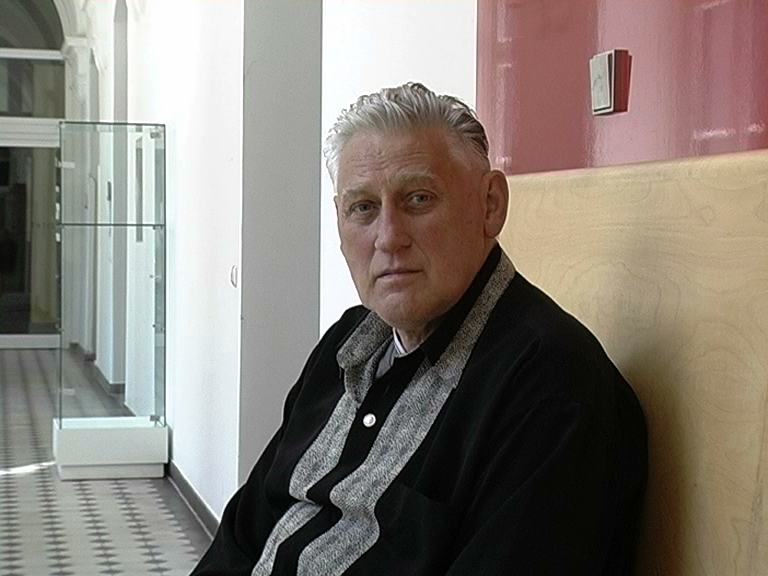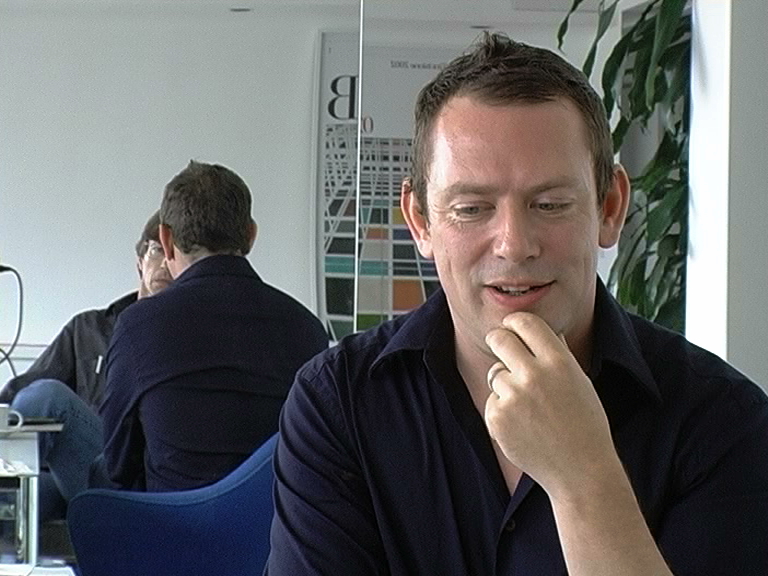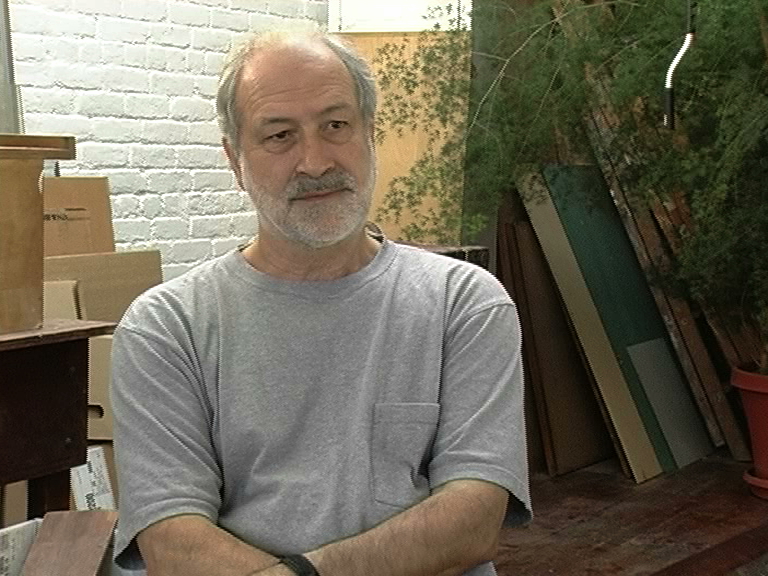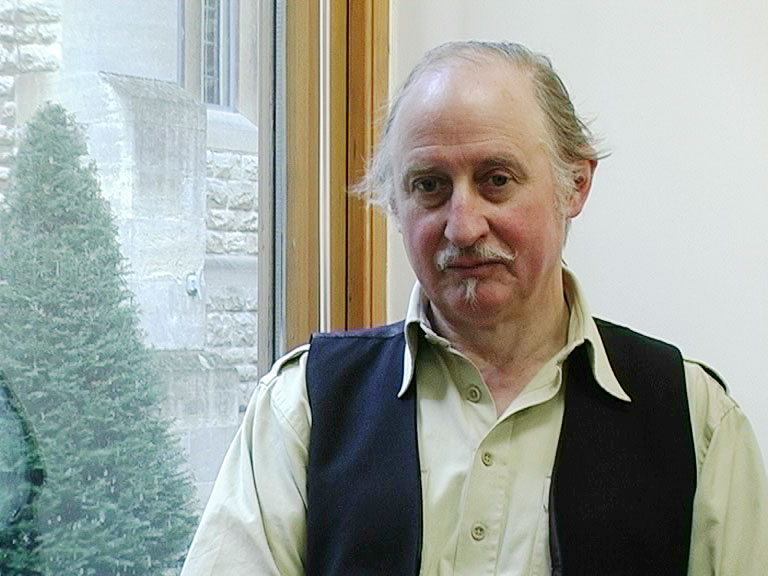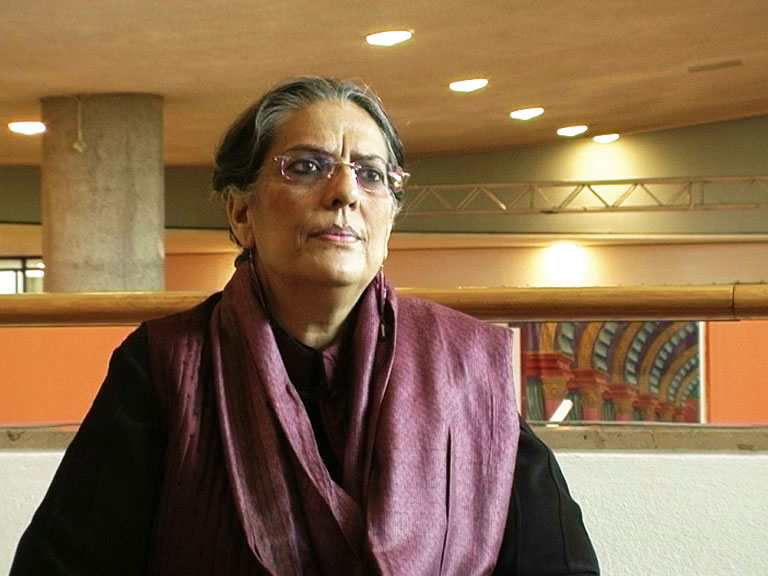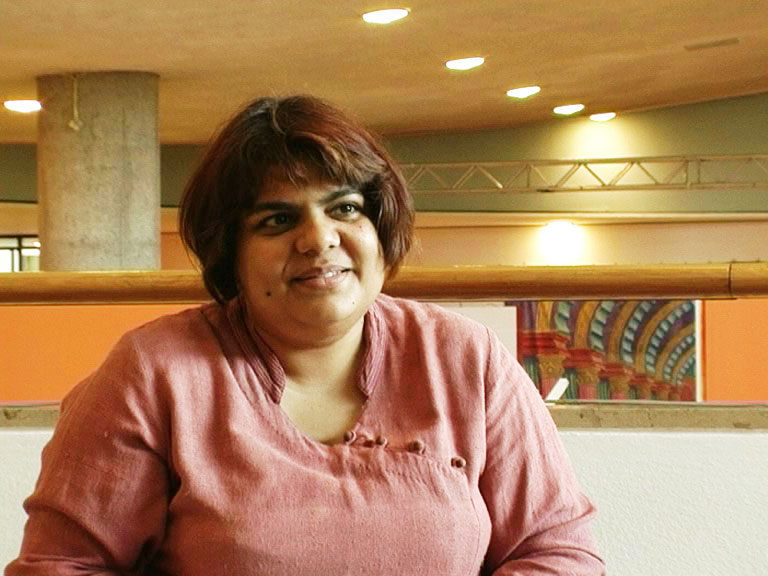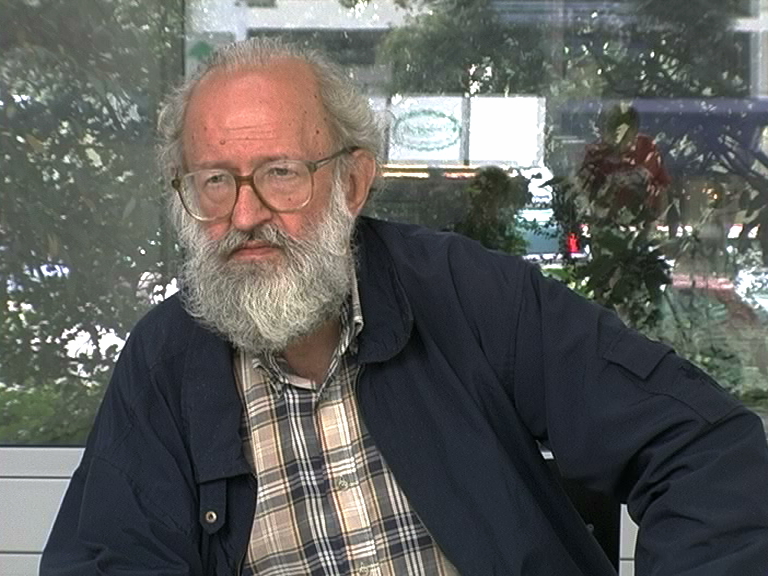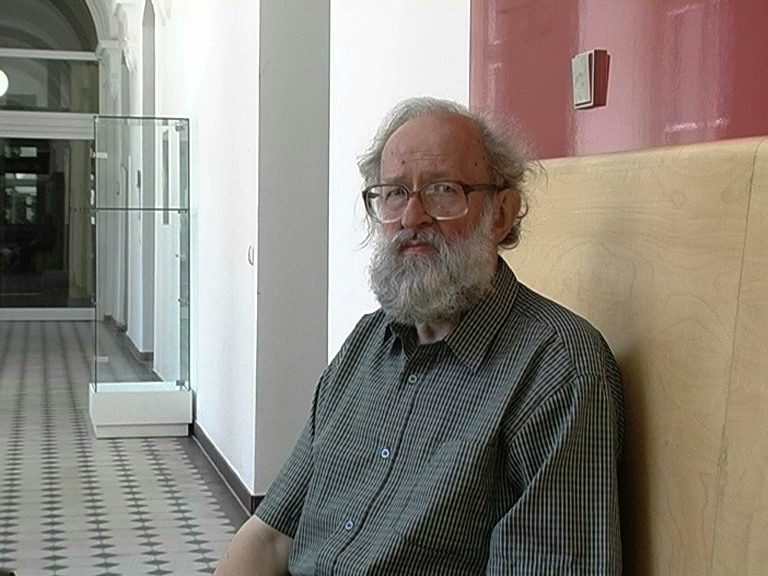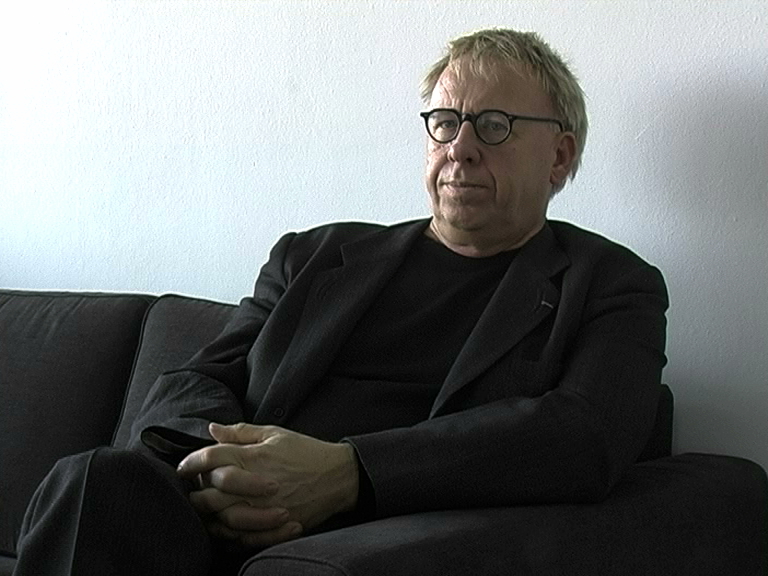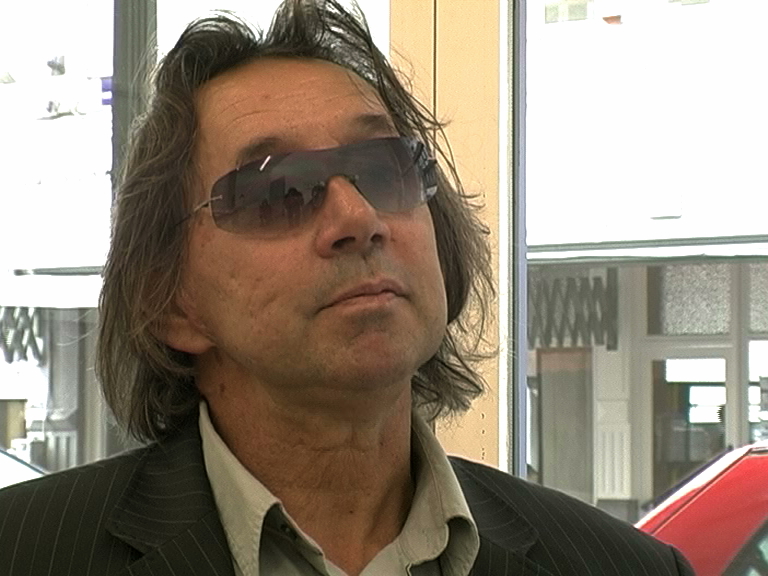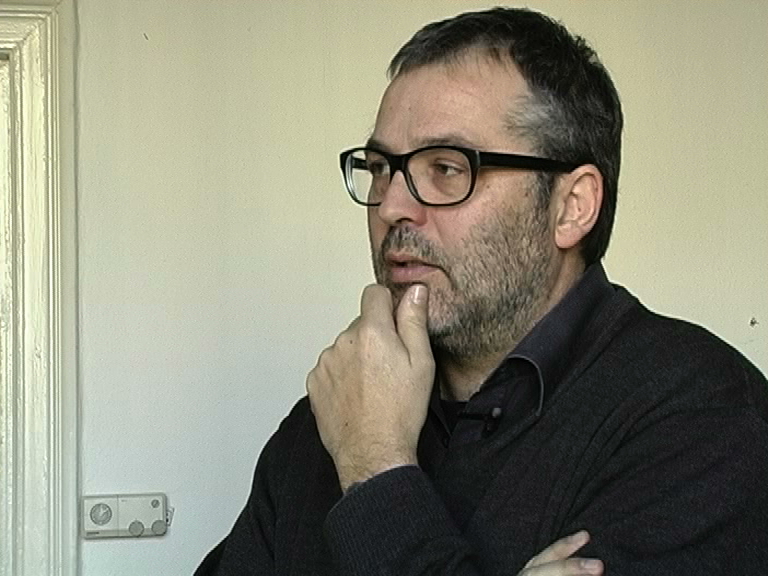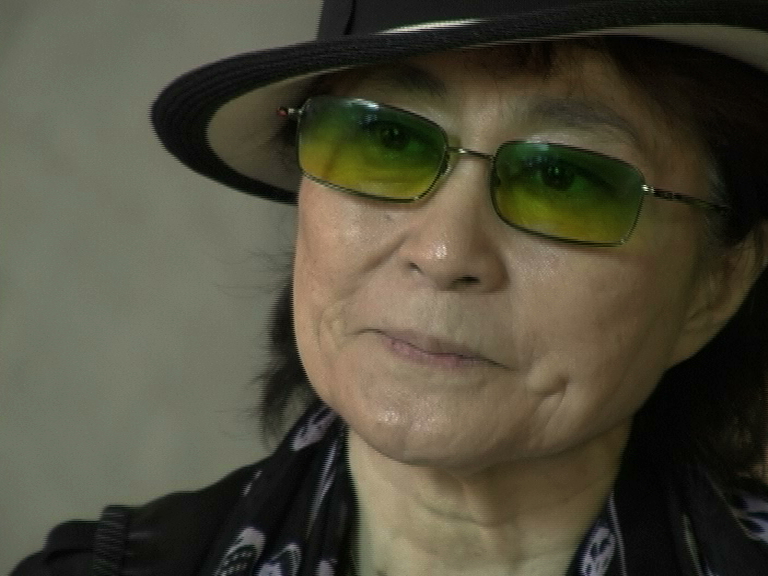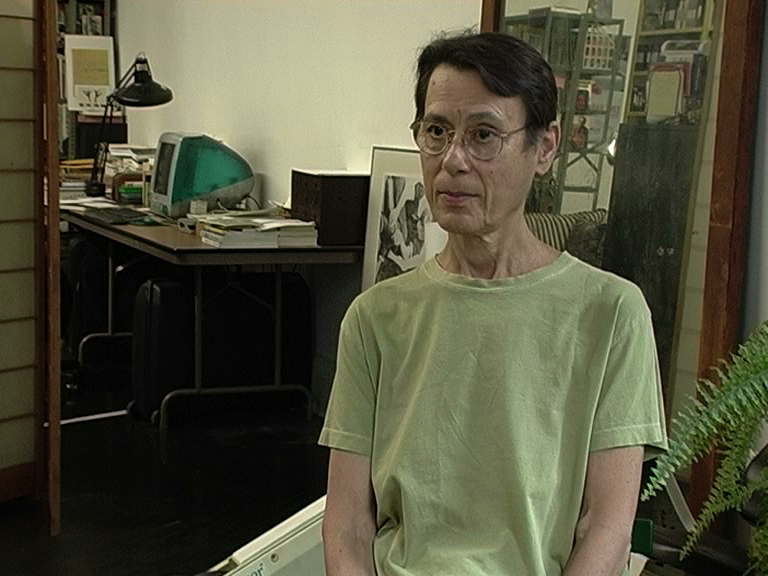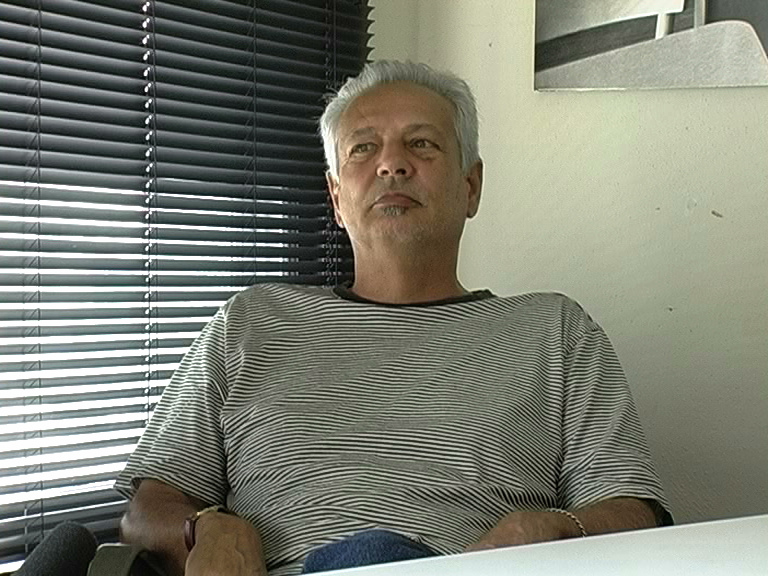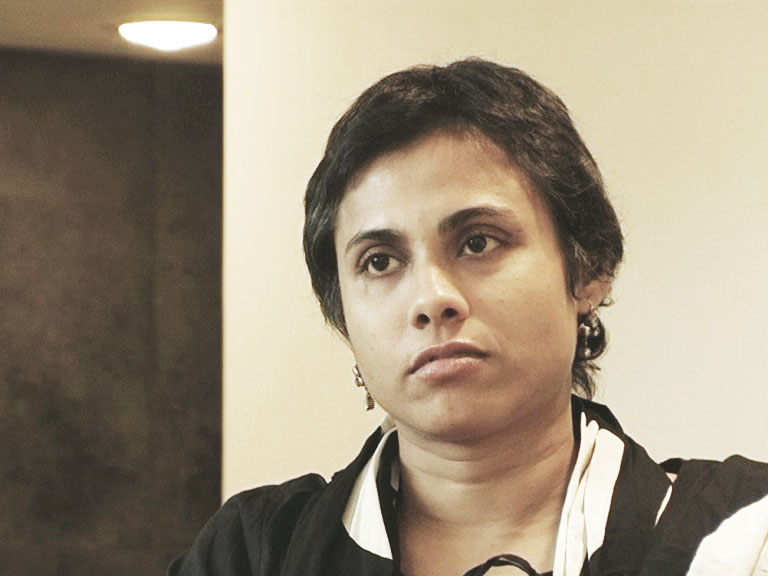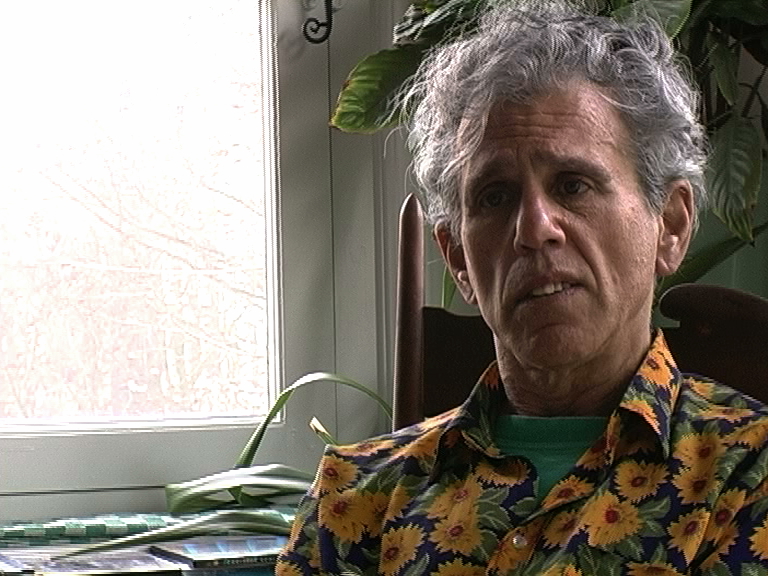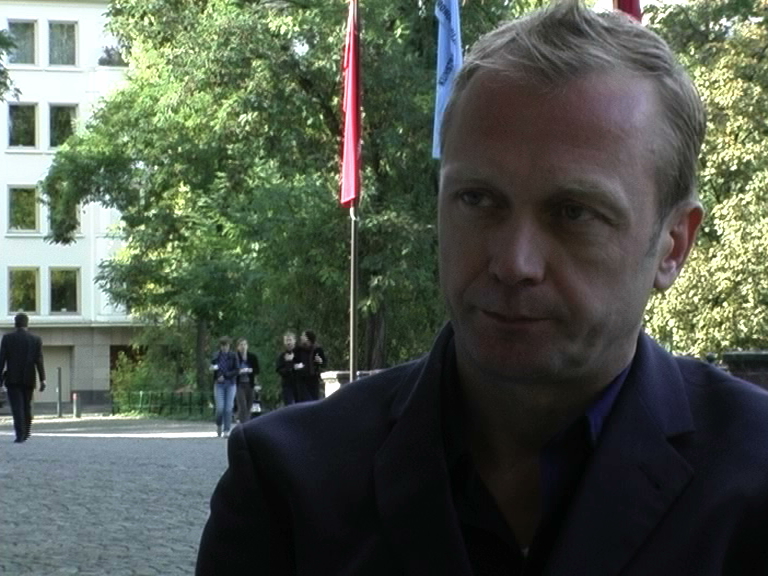S.S.: I’m probably one of those people who do not … I’m not in favor of the term, but I’m also basically not in favor of any terms, all the movement terms, …Expressionism, Cubism […] There is much they hide, in my mind, as much as they reveal. In other words they tell you at the expense of hiding other things. So I’m against the -isms, whether it’s Conceptualism or conceptual art or something like this as much as for Conceptual art as for Minimal art as for … I mean, you name it. […] And it’s particularly the case with conceptual art, because there it was a very broaden(?) way, if you look at 1969, … the grab bag, the cacophony., the times of the artistic types of artistic expression, what you call now Land art, Oppenheim, Beuys was around, the Bechers were around, photography was just becoming a … understood not as a … well, I wouldn’t say formal expression, but as the connection to fine art thanks to the Bechers.
Beginning of interview
S.R.: We are happy to be invited here. So I have some questions and I’m sure that you will suggest some sideways and some answers which are going in different directions. Let me start with a quotation from Robert Barry. Because he described your position, your function, for your multi-function as the most interesting one in that time, more interesting than the artistic, because you did the whole conception of the gallery and you brought the communication out. So he said: “He was not a gallerist, he was not a P.R. manager, but he was much more ….”
S.S.: Yeah, I’ve heard that. First, before we get into the heart of the matter here, a little side track. One: The activities your are talking about took place, 30, 35 years ago. My life has been involved with other kinds of projects. I left the art world in 1972, specifically leaving New York, moving to France, for personal reasons. My day-to-day contact with the art world is relatively minimal – to use a pun, as opposed to conceptual maybe – But is relatively minimal insofar that I am involved with other kinds of projects, and so I don’t have the day-to-day relationship to the art world that Bob, Barry or Lawrence worked through for 30, 35 years doing their work … In the past number of years there has been a re-awakening of interest in the period for a number of reasons which are probably to discussing in the afternoon … and so I’m called into play in function of this interest of one of the players, one of the active players for the period. So, in a certain way, my recollections of the period, or at least my stories -let’s call them little stories-… about the period do not have the same continuity, even of repetition, because a lot of the myths that grow up in the art world are things that the artists or other individuals who are active in the art world carry forward for years and years and years and just keep saying them until they become part of art history or something. I don’t have that history, in a way, which takes me to this moment in time. Which means a certain forgetfulness, holes, even reading Alex Alberro’s book, there’s lots of things I didn’t absolutely remember … The hole is there because it’s not something I really think about 24 hours a day, the way I’m sure Bob or Lawrence or Hans or anybody […] was really thinking about all this. Okay, I’m saying […] There is sort of a little distance from the period.
S.R.: But that is fine. You have quite a distance in personal matters, and the other people who are still in the art context, in the art world, are much more involved in a personal way, in a sense of an economic way … an ego way. For me, one of the most interesting approaches is how you see that time. Because, for example, Alexander Alberro puts in his book “Conceptual Art” in the context of publicity, he was describing your function as a kind of avant-garde art dealer or avant-garde gallerist who was becoming something like a role model for art gallerists in the 80s, maybe.
S.S.: Well, it was probably not so much for art gallerists, but more for curating. I think what I did was not a role model for dealers or gallerists, because I was a lousy dealer. I mean I was anywhere near as good as the … even the modern successful galleries. I didn’t like the business of art, frankly, I never thought of it as a business. I mean I knew you had to make money and pay your rent and eat.and have a good time.. […], buy art cheap and sell it expensive and things like that. But that was not what I was about. My project in connection … in very close, intimate connection, that’s one of the aspects of my work at the time, my work in very close connection… in symbiosis, in a way, with the artists I was involved with, was basically to find an environmental situation which allowed them to show their work to the best advantage, but also the situation which corresponded to the nature of their work, because it was no longer a question, or it became clear after a very short period, that it wasn’t particularly involved with a specific space, it wasn’t involved with a traditional space, where people went to […] on Saturday afternoon to have a drink and […] to look what’s art today or this week or this month or something. It was to find other channels of communication to be able to show their work. And this was a much more dynamic problematic and particularly posed by the nature of the work they were doing. Imagine Bob or any of the other artists … that I was involved with … and many others too, who I was not involved with, who shared similar exhibition problematics to be able to have their work shown. And even one of the problems in certain cases was: How do you even make someone aware that there is a work of art there? Those kinds of questions. My job – if you like – was to try to find those environments. Trying to find… money and […] to be able to produce the environments to do this. During this period when I was active, which was basically between 68 and 71, that’s what I was doing, I organized I think 21 exhibitions by myself and my own energy, with a few collector friends who put in 500 Dollars here, 1000 Dollars there which allowed me to do the exhibition … to be able to do it. So that was what I did. One of the background aspects to this … personal history aspects to this is that I’m not a rich person. So I didn’t come to the art world with the idea of making a fancy gallery or something like that. I was constantly looking – as I am now, to be honest with you – ways to do things that were not particularly expensive, I didn’t involve complicated wheelings and dealings and grants, and foundations and funds and hustlings and things like this … to be able to do the projects I did or was doing. In that respect, the work that the artist was doing was like a dream come true in a certain way. I didn’t see it that clearly at the time but it lent itself to the kind of way I lived my life. And so the question of that […] kind of working relationship, that was a very new relationship. […] Because in the past you could say, a dealer – and again, I’ve never thought of myself as a dealer. I only had a physical gallery for about 18 months, and it was really a bummer for me … no one comes, there all the time. I was there from the fall of 64 to the spring of 66. What I showed, of my consciousness if you like, what I was doing was like a total crap shoot. Yes; I showed Lawrence twice, I did one or two interesting things, but I really … my head … couldn’t figure out what I was even doing, and frankly, I don’t even know why I did it entirely. But it was a very bad experience, not just economically, because galleries in 1965 were not going businesses, only if you were very, very successful or really came from a rich family connection or things like this. But it just wasn‘t for me, that shopkeeper kind of thing was not for me. Maybe if I’d sold lots of work and was living high on the hard(?) I would have said: oh, galleries, great that’s really where it’s at…. but that was never the case for me. And then there was a period afterwards, after 66 going to 67, when my relationship to these other writers which included Carl Andre, which was like a transitional person, […] very much involved in sculpture in a very untraditional way, still today, in fact – then leading to Lwarence, Joseph, Bob and Doug and the exhibition programme, the exhibition history that existed. But at the beginning it included things even like the Window show, like one of the first outdoor exhibitions of Carl, Lawrence and Bob, matter of fact a triple show for Lawrence, he did these string and staples and things. (short discussion) There were two shows in ‘68, in January and another one in May, I think. The May show was outdoors in which Carl Andre did a very long piece in bales of hay; Robert Barry did strings across two buildings, and Lawrence did strings and staples, which was a shape cut out on a very big lawn or something like that. One of the first, if not the first show that actually artists went to make something in situ as opposed to having a spot in a city hall or a something like this….
S.R.: If we focus on this, it’s getting clear, it’s very soon getting clear that your function in relation to the work of the artist as a curator is totally different from the function of the curator in a White Cube. Because if you use a place in the so-called public sphere that is not defined as the presentation place for art, you have to settle and you have to to define this place as an art-reception place. And I think this exactly marks the specific new work that you did.
S.S.: In a way, yes, but it’s also framed by a lot of activities that were going on at the time, for example, Guerrilla theatre, Street Theatre, Graffiti etc. You know when you think of graffiti, street theatre … I remember Twyla Tharpe was dancing on building tops, in the streets and through the museums. There was a lot of attempt, maybe ours was the most crystallized and the most thought-out maybe … that’s not the word- the most crystallized, but there were a lot of attempts, and if you look at the period … Even Daniel Spoerri’s bar in Düsseldorf or something … as an art activity coming out of Fluxus and all that kind of thing. So there was a lot of attempts to try to get away from a formalized art physical space but also an art social space in a way. And because of the nature of work of Lawrence and Doug and Larry and Bob – their work lend itself to that possibility more than most other kinds of work; because it wasn’t space-dependant, it didn’t require the space necessarily – sometimes it does – … and it could take place in various kinds of media which before were just not viable means of exhibition. (…) One example is the use of a catalogue as an exhibition. There have always been catalogues, although I’m sure in the last twenty years catalogues have multiplied by a thousand times in the art world, not just because the world of art has multiplied by a thousand – which is also true –, but also because people have realized that many more people see a catalogue than ever see an exhibition. And it has a life, a temporal life which far extends the 5 or 6 weeks or two months or things like that … But there’s another factor too, it’s that the art that was created … (kurze Unterbrechung Wdh.) What I was trying to say […] is that from the role of the catalogue with this kind of work changed dramatically, and I have referred to it as the difference between primary and secondary information. In other words, it was possible with the work of Lawrence, Doug, Bob and Joseph and many other people too, not many, but other people too … to be able to … a printed piece of catalogue or a printed object could convey what I would call primary information about the … It wasn’t about showing a color painting that was this big which in reality is that big, which is just like a little sign pointing towards the real art – it was all there. It’s not just an inverted relationship, but it’s another kind of relationship. That opened up a whole series of possibilities, theres many other ways … Printed matter was one of my things. I like publishing books, I always have and I suppose I always will, although I suppose I should spend a little more time thinking about the web things like that… I personally have always been involved with publishing, I’ve always found it extremely gratifying. The work that they were doing …or the ideas behind the work that they were doing lent itself to this kind of presentation. So certain shows, like the January show, we tried to – succesfully or more or less I think – to invert the relationship. In other words, there were two objects from each artist in the physical space, which is like examples for what was in the catalogue. And the catalogue was the full show in which four artists, each did eight works or something, presented in the catalogue. Even if you didn’t see the show … Lawrence of wall removal or Bob Barry’s radio waves or whatever. So … you got it! I mean, it wasn’t about coming into 40th – at that time the building was at 52nd Street – It didn’t mean you had to go to the building: Oh he’s so fantastic”… ads in the newspaper […]. It entirely wasn’t about that.
S.R.: When I take this catalogue, you mean, this is the exhibition.
S.S.: Yes. This is not the case for all the projects, but in many of the projects … This wasn’t the case for all the exhibitions, but it was an underlying aspect of, like, the Huebler exhibition e.g., for the January show, the Xerox book, for example. It allowed you to … I mean that was it! This was not like a promotional piece … or like: for the real work you go into a gallery, there was no exhibition.
S.R.: …if I understood it right, that was a little bit the critical view of Alexander Alberro, because he said, from that time on when you managed to do exhibitions in a printed version like this, that was a very important step for art. // I agree, I agree…!
S.S.: But in the last times, more and more this has become the art of public relations.
Ok. (..) I think very highly of Alex, I think very highly of his fundamental research into the period. Very few people, or nobody knows the material, the dates, the whos, the whats and the wheres.. as well as Alberro; he spent much of his working life, five or ten years … scratching out all that information. And with the exception of Lucy Lippard […] … who has left the art world, who left her interest in this period … He knows an awful lot about it. But he thinks that a publicity agent is a great thing. He thinks of it as a positive thing, I think of it as a negative thing. I was against the subtitle of the book “The Politics of Publicity”. I was going to use a more Habermas-kind of Politik, or the publicness or the public sphere I suggested as opposed to the idea of this is like a kind of like an advertising hustle in a way … maybe like someone […] like Saatchi … He’s like really a promotional wizard of advertising […] that’s where his life-experience comes from […]. I didn’t like the word publicity, to me it has a completely negative connotation. We discussed it a long time, but somebody at the press, maybe Benjamin Buchloh […], they really insisted on it; I gave them a whole list of alternative name that where turning around “public sphere”, “public…” to avoid the harshness of the word. But that’s maybe a difference … a generational thing. There’s a little bit of Warhol in that, too, sort of an advertising genius. But I never thought of myself as that … I’m not insulted, I don’t agree with that; the facts are correct … but I don’t think of myself as being some kind of advertising genius, […] hang on a pole on the Empire State Building for art or something like this, I was never like this. I’m sort of a very private person and although I worked very closely with these people, as I have worked with other people in other spheres, … I’m not into that kind of … that’s not my persona. Like everybody, I suppose, I like to be well-known and respected for what I did and what I do, but I really don’t need all the hype shit that goes with that kind of thing. So I don’t see myself as a […] kind of … I mean I’m kind of offended by … the Warholian kind of … sort of mass-marketing of art. […] If I can put it another way, in more industrial, economic terms: I see myself being involved with fundamental research, not with mass marketing. In other words, I’m not interested in making Lawrence Weiner a household name, or Huebler, or something like this … no more than I’m interested in everybody following or picking up what I’m doing now […]. I’m interested in that participation, I’m interested in the search, the investigation of new modes of whatever, in this case of art making or the art making process. So, I mean, that’s how I see my work. And to a certain degree, to the moment that I think I’ve achieved it (…) which is never clear … I mean, it’s not that it’s clear… I leave it to do something else. In other words, I felt like that, as much as I’m capable of doing, I can’t take the project any further, it’s becoming – with these artists for example, and with art in general– you become like a caricature of yourself: re-do it, get some more artists, put them in the pipeline and hustle them because I’m well-known […] -which is what a gallery does! They make a reputation, they build up a network of relationships, museums, collectors […] friendships … and then they put a young artist in the center … Some do it very well, but that’s not what I’m interested in. I mean I’m not interested in being a gallerist, that was never my intention. Although, to be perfectly honest, … I’m assimilated more with the independent curator as a phenomenon which appeals to me more, if I had a choice. Again, I would never use the phrase myself; I never thought of myself as an independent curator, probably because a curator was someone who worked in a museum. There was no independent curators. I was just doing my thing with these artists, with many artists, too, […] I was just doing my thing… (break, telephone)
S.R.: …Free curatorship. Or if a free curator is possible for you or not …
S.S.: Oh yes … I was assimilating myself with the experience of curating in a way … although the phrase itself never came up. I mean I never called myself: Hey I’m an independent curator or something… It was only when that phenomena – which has developed over the last 20 years with independent people…. which is related of course to the growth of museums, the role of museums, which is … etc.; a lot of the models can be found in the music industry for independent curators, like independent labels or … even independent filmmakers… feeding the big filmmakers […] That was my role, more than a gallerist. I never saw myself as a gallerist…
S.R.: If I see it right, you had a Marxist background …
S.S.: Yes, absolutely… It wasn’t a background, it was a development coming out of this. In other words, I didn’t come into the art world with a clear political vision. Anyone has a clear political vision … but it was only for the Vietnam War, a lot of fundraising and activity in the art world, Art Workers Coalition, people were involved with that … Carl, … Lucy was involved with it, a lot of people and I too, to a minor degree, was involved with it, producing, picketing in the Museum of Modern Art … That was part of my growing-up, too. And that, in part, led, I don’t know how closely it informed my art-organizing projects or anything like that, but it certainly led me to a series of Stepps, which eventually took me away from the art world, because, actually, when I left the art world which was in the spring of ‘72 and moved to France, what I did was political publishing. I published left books on the media, including Marx, including cultural imperialism, including a whole number of books … which I did for many years. And in the latter part of my work in the art world, I actually became very interested in journalism, newspapers and things like this … And one of the ideas I had which never … fruictified or never bore fruit was to develop some kind of alternative newspaper. It was just too much work, too much, it just doesn’t finish … But it was something I did look into very carefully when I was in France, which is where I moved to … I did talk to a number of journalists there, a number of things were going on there concerning left newspapers. But I went off into research, Marxist research on the media, and that’s what I was involved with for many, many, many years …
S.R.: …If I see it right, you also have a kind of a critical impulse when you are talking, when you are writing about that time as you were involved … For example you criticized the text of Benjamin Buchloh in the French exhibition … at that time very famous text „From the Aesthetics of Administration to Institutional Critique“ … You had some points very … for me it was convincing …
S.S.: I was kind of shocked. This takes us back 15 years … this was 89. I was kind of shocked although I had not been involved with the art world, and that was the first museum exhibition to try to bring together that moment of so-called Conceptual art. I was kind of shocked; I hadn’t been aware of that. I owned a lot of work myself, in my personal collection and I did give an interview and things … And I was kind of shocked … sort of what Buchloh said, because I had always had the impression from Lawrence and from Daniel that Benjamin was like a progressive – and he is! But I found this a very conservative kind of, you know, typical: “Who did what first?” and all that kind of thing and I actually criticized him very strongly when they redid the… I actually wrote a small text… But I actually criticized him very strongly for a sort of the… – I forgot the words I used, but it was actually published-
S.R.: …formalistic…?
S.S.: Yeah, formalistic kind of thing… […] And the fact that this history was very limited to Dan Graham, I mean very … Marcel Broodthaers… There’s a few arbitrary selections of ideas, and totally ignoring even reference for example to the Vietnam War. I don’t even know how you can talk about our period without talking about the impulse behind that, and the students’ movement in Europe -which I would say profoundly affected Daniel- … and many other people I’m sure … and also affected us, not in the sense of making our activities more political, but making you aware of the power structures in society. That was definitely one of the underlying problematics … under some of this work: the question of private property, ownership, longevity of art, the permanence, things like this… which every one of these artists were contesting in their own way, with various degrees of political consciousness, if you like, and things like this … You really can’t look at that period without thinking about that […] You have to remember too that in the early 60s: Marshall McLuhan, information society – all this was coming up here! And although, […] we did or the artists or myself not fit into it, this was the subtext, the undercurrent of what was going on there. So to see this also as part of or a manifestation of or influenced by the information society; I remember they were talking about the third sector: … finish up factories, and everyone is going to be xeroxing, communicating … advertising agencies became super important, things like this … […] But this was the toile de fond, background for this kind of activity even though you could really think twice about the political consciousness of these artists in various degrees. A number of years ago I did a project, which was recently published, called “The Context of Art”, […] in which myself and two women, German dealers in Düsseldorf, the Frickes… agreed to do with me, for which we asked about 100, 120 artists who were active in 1969, just happened to appear in the “Attitudes” show, my shows , Konrad’s prospects in Düsseldorf and things like this … and we asked them what they thought of the last 30 years […] It was called “The Context of Art” and it was published first in French in 1996 as an issue of Art Press and it was just published now in German and English by … Marzona’s Son, Daniel Marzona who is in Berlin. […] What we tried to do was try to get the feelings of the artists or their understanding of how the world had changed since 1969 to the questions, this was in 1993 or 4, something like this … It’s kind of surprising, the variety of answers but also the political; […] some people say, the world hasn’t changed at all, I’m just a little richer, more successful; whereas for me, when I look at the work again – Rumple Stiltskin? rather like Rip Van Winkle […] goes to sleep and wakes up and there’s a whole world. This was sort of my situation in a way, too. In the sense that, well I wasn’t really sleeping for 20 or 30 years, but I did miss what happened between 1970, ‘71 and what happened up until 5 or 10 years ago because I was, […] I wasn’t involved with that. I just heard it from friends … there is a painting thing … and then there was this business thing … in the 80s … stuff like this. But for me, looking at the art world between when I knew it and what it is today, it’s absolutely unrecognizable, not just qualitatively but even quantitatively … I mean the amount of galleries, money involved, its relationship to capitalism, the art schools, the art bars, the art courses, […] – it’s just totally unbelievable. […] Even just quantitatively, the amount of these things going on – and of course, with that you have a qualitative difference in what art is and so. I had the impression that the artists has become … another profession if you like. Not quite the same as a lawyer or a doctor or a teacher, but a more acceptable profession. It’s possible to think of becoming an artist – going to art school or not or going to Yale or going to … becoming an artist – and think about maybe earning a living as an artist. What I remember, looking back 30 years ago, you couldn’t say, I mean – there were … rich, successful artists, but the idea that that was the possibility of a career choice.(laughs) I mean it’s just not through. When I was involved with producing one of my last projects … “artists‘ contract”, royalties and certain kinds of control […] In the course of doing that, I spoke to a lot of artists which I’ve normally would not have spoken to just to orient myself or ourselves, it was done with a lawyer friend… The impression that I had, even from artists who were very, very successful, I mean – call up millionaires … still the predominant attitude was that they were workers vis-à-vis the collectors who were like the capitalist exploiters, even if they were ten times richer than the most capitalists – I mean at the same level […] That was the mentality of the time, and that has changed so dramatically, that artists, not only many more artists but the model of an artist has gotten much closer to a rock musician, which in turn is coming to a fashion designer, which is … like another successful creative business person […]. This has obviously has had an effect on what the art world looks like, and for me doubly so because … I just closed my eyes and then looked around and saw all these things. So it’s a very different thing. But to get back to Conceptual art or what we were saying at the beginning or what we were saying earlier. (break; terrasse, Publication: The Context of Art …) It was just published … last year. And it’s one of my last projects, or one of my recents… [……..]
S.R.: … lots of documents…
S.S.: Basically, what I did – the Fricke Ladies did all the interviews, which is all the hard work, let’s say. But it also deals with, what I considered (…) To deal with that kind of history …
S.S.: I was interested in the history which would incorporate,… or at least not the history but the elements for a history which would incorporate both the successful artists as well as the unsuccessful artists as well as the people who… […] History is written from the point of view of the people who still have the voice, the power to be able to be heard. So this was an opportunity to be able to hear from everybody we could find. And we actually tried to track down over 120 people. There’s a list at the beginning. By the time we did this, like 10 or 12 a day/are dead? … actually you couldn’t find like 10 or 15 people… totally disappeared. Many people didn’t want to answer didn’t answer… not so many, let’s say about 15 or 20 didn’t answer… But most of the people we had to go after or the Frickes had to go after them to actually interview them […] The answers are very variable…
S.R.: Once you said, that your only interest or your main interest is the artist and the social dimension of the production…
S.S.: Yes, that’s definitely my interest, and my personal history goes from the very specific promotional aspect – to use the phrase „promotional aspect“ – to a more general, systemic, social aspect. […] My first projects were very focused on individual artists, then there were more artists like the March show which had 31 artists from all different stripes, we knew the artists… Then I did a project in London at Studio International where I asked eight art critics to select artists; then I did the “Artist Contract”, then I did political fundraising etc … My personal interest got more and more socialized and more and more social consciousness and things like that… to the final point of just stopping … or I just changed my interests …
S.R.: If you look at contemporary art, because there’s a lot of contemporary art that looks like Conceptual art – but often it’s not epistemologically rebound, for example Lawrence Weiner’s work or Joseph Kosuth’s work, which is very developed out of a philosophical, linguistical thinking … Wittgenstein and so on. Do you see the difference when you see contemporary art?
S.S.: I don’t see contemporary art … I mesan young art as much. One of the reasons is that it takes a lot of effort to do this. I mean, if you are interested, you really have to be interested; […] you can’t just spend an afternoon and walking through and understand what’s going on. Mayo … who I live with … she’s a curator at the Stedelijk, and … because of her … I have more contact with younger people, because she’s constantly doing exhibitions … But I really don’t give it the attention it deserves. We go to the art schools, to the Rijksacademie here and there for openings and things like that. But I don’t look as carefully as obviously you look for example. So it’s difficult for me to make comparative statements. It’s hard to, I wouldn’t venture it; I wouldn’t even say what I’ve seen lately that I really liked […]; it wouldn’t have any sense for me to do that. I think because there’s so much being made and so many people active …, it takes a lot of time and energy to … […] It always takes a certain amount of energy to understand what’s going on around you, in any profession, anywhere, but now because of the multiplicity or the volume of people working… I mean the exhibitions go on and things like this, it’s almost for me like, by chance … It’s really difficult to make any kind of comparison with my generation. I could even say that … you could even question how much I really remember from 35 years ago…
S.R.: How is it when you see not contemporary art, but when you see the arrangements of the material you brought out in the end of the 60s … when you see work of that time … how do you behave, what does it feel like?
S.S. It’s hard to say that. You mean in like a museum or an institution environment […]?
S.R.: Because I want to come to one point … because once you said, it’s wrong when the museum puts invitation cards on the wall …
S.S.: Yes, the presentation. The museum itself; you really have to think very carefully about of the role of the museum in valorising or giving value to things in a way … You could say that it sort of denatures, sort of changes the nature of all kinds of art that would nromally be put in there. But particularly, the kind of sort of more ephemeral art activities that hardly lend themselves to the permanence of a museum. […] A museum, in very real way, is to make permanent … sort of the artistic moment is something, but you have to have it extend through eternity. There is an underlying belief that art is universal and millions of people … we understand the Greeks or the Romans or the Africans … which I think is total bullshit; it’s our egotism in a way… Maybe it’s good that we conserve these things and protect them but the idea that you are ever going to understand all the imagery in a medieval painting […], the way probably a peasant from Italy or Germany would have, just because he … “l’air du temps» …– it’s just totally ridiculous. The museum has that function and it’s inherently […] It takes that sort of spontaneous character away, and in the case of this kind of art it’s more dramatic, in a way. I mean it also happens with other kinds of art, too. […] You mentioned the invitation cards of Barry’s or the idea of coming around a street corner and seeing something on a wall or a building. I mean, graffiti, to use a general term … The whole point is you are just confronting it on the street and in your daily life, in your coming and going […] … these influences you’re thinking in one way or another. The museum is meant to sort of make eternal a certain art experience that not necessarily was intended to be done in that way. This is a sort of a very -I don’t know if this is a really capitalist idea – but this is the idea of preserving things, ostensibly for generations to follow, but really so that to create value or selectively create value, so it’s passed on to future generations in a way …
S.R.: This is a kind of power impulse that the museum has because they are writing the history, putting the things together they can get; they don’t get the things, so they are not in.
S.S.: Exactly. That kind of power, that kind of selectivity – of course we all do that in our selections – but museums have evolved in such a way that they have an extra strong power to be able to give this kind of vision in a way and of the museums, certain museums far more than others, have the ability to create value or sustain value […] But the problem is really, on a social level, is that we allow them, or society gives them that prerogative in a way … -because that choice aspect is the same that we have. If you go into a supermarket or something, you’re gonna choose this or this … you are making a choice […] But the problem is that certain choices are more important than other choices. And that is something that the capitalist society, the social society, […] the society in which we live gives incredible amount of value to museums to be able to do this for us in a way. And it takes away our critical edge of thinking about things in our own way. I’m not talking about the art world just, but I’m even talking more about the general world because these kinds of institutions do try to cater to a much larger population. And so a lot of the people maybe […] would go to this, the way you go to a church; this is … the way history was … the MOMA has been often criticized, even the new building or the new kind of history they have established. I wish they’ve always had before […] to be able to establish a certain line of history…
S.R.: More or less, I have two spheres I want to bring together The one is that you already mentioned, “the artists‘ rights..” which I consider one of the most important steps, if you see the development of art as a linear, that is problematic. But to have something like that… it’s a big step even if it’s only used by some artists. And the other thing is that I want to bring you, push you a little bit to say something about the influences for yourself, for your work, for your thinking, your background and the artists which came to you as a partner. So one…
S.S.: Which do you wanna do first? The contract…
S.R.: Maybe the contract can be something like a second step.
S.S.: […] The background… A lot of it is chance, let’s be clear about that, a lot of this is pure hazard … chance encounters, sniffing around … There’s certain affinities which I’ve mentioned already, concerning the economy of means, the fact that practically all the work you can think of was not expensive, that’s really very, very important. The fact (…) Let’s start from the beginning, I’m losing myself …
S.R.: What do you consider as the most important influences for your own work?
S.S.: My own work I could think within the art world – I was mentioning I started off, but I was not wrong […] Individuals, probably? Two people come to mind, but basically before I get involved or talk about them is that the criteria for my interest was people who were close to the art making process. Two people come to mind who were more or less my contemporaries – they where more or less my generation… a dealer called Dick Bellamy who was active in the early 60s … – sculpture and a lot different things-, and also a critic and –I suppose you call him a teacher- who was active in E.C. Goossen … doing relatively standard shows, Barnett Newman … MOMA; he did a show which stands out as important; “The Art of the Real”, a travelling show done in […] 68 or 69. Dick Bellamy had a gallery called the Green Gallery. But it’s not so much because of what they did, but rather their relationship to the artists which influenced me or made me think about what I would be doing or what I considered I could do in the art world. Both of them […] where much older […] their relationship to artists […] that’s where the action was … So I looked to them or at least they influenced me – Dick particularly had his ups and downs; in terms of money, personal life and whatever. And the same can be said of Gene Goossen who was among other things … he ran the Hunter College art department which gave a lot of people jobs, very simple – he also had a very keen eye and was a critic and a lot of things like that. Basically, both of them had a very highly respected and close working relationship with the artists that they may have had to deal with, but in very different ways. That’s what I felt a dealer should be doing amongst all… amongst everything; developing, working with artists, to show their art … The fact that the artists turned out to be making things that they did … A lot of the reason you are sitting here talking to me is because the quality of Lawrence’s, Joseph’s, Doug’s and Bob Barry’s work has, I wouldn’t say sustained the test of time, but obviously has had a profound influence on art making practice since 1970, I mean … And I’m part of that […] history. But the two people that I mentioned … […] I remember Kasper König running around, I remember Walter was close to things like that, but they were more contemporaries in a certain way, whereas these other people were … even if they were five years older, but they were more involved with the art world in a certain way. That was like the key to it; what I would be doing was related to a close working relationship with the artists, whoever they may be; and then specifically with these artists, having to do with my class background, my class […], my economic situation, my interest in publishing, which […] was there well before, you know I collected books, before I was involved with the art world, at a certain level, in any case … That was like the fundamental background, … my relationship to artists and why I dealt with them the way I did …
S.R.: Maybe we can have a short focus on the development and the value that this “Artists‘ rights transparence“ took for you. Because I think it was a very specific historical moment …
S.S.: I can give you a certain summary, summarize it. One of the backgrounds was as I mentioned earlier was the work of the political activity in the Art Workers Coalition; many people were talking about this kind of problem, about artist insurance… At that time artists would live in lofts which were illegal […], you weren’t allowed to live in lofts, they were tolerated, didn’t really exist … a lot of artists had economic problems, heating their lofts … So there was a lot of talk about artists’ rights in general, and enforcing them. One of the things that provoked the protest against the MOMA concerned Takis had some kind of mobile sculpture that either the museum presented in the wrong way or took out or did something, manipulative to it … this was the trigger for daily or weekly protest in front of the MOMA for six months, and meetings and things like this, again in the context of the Art Workers Coalition, artists political activities, also related to the War, the anti-Vietnam activities, fundraising – we often did … fundraising things; I myself did at least two or three conferences which people would pay two or five Dollars for […] to discuss various contemporary art problems or questions and things like that … So, this comes out of that specific environment in New York, but in Europe, droit de suite, the artists’ rights, had existed under Napoleonic Law since the early 19th century, and artists in France have always had the right to a certain percentage of their work, a certain moral control over their work … how it’s shown, postcards can be made of it … So there is a an existing structure of law in Europe which already deals with some of these questions. What was original about this particular project, which was written by a lawyer who was very much what was called at the time a sort of a „storefront lawyer“; someone who was involved with people, tenants, sort of „do your own law“. This was an activity which was going on at the time, too -[…] law was something … a very specialized thing. The man with whom I worked on this, by the name of Robert (?), was that kind of progressive lawyer who was involved with storefront work, […] petitioning landlords […], generally a progressive kind of law … And so this was a certain kind of art-law project […]. And it was also conceived, after I consulted with tons of people – which was also a lot of fun, because normally I would have no need to see famous dealers or famous artists, I would have no contact with them in the course of my normal work, which consisted of very few people, Lawrence mostly, and Bob … So it gave me the opportunity to talk to a lot of important dealers, Art Dealers Association …(short break)… It gave me the opportunity […] to speak to many different artists, in a way, and what we were trying to do, Bob and I, was to create a relationship, easily not just controlled, but easily maintained between the artist and the next purchaser of a work of art, and giving him or her a line, I mean a legal line, for all subsequent purchases. We weren’t interested in institutionalizing it, setting up a national foundation for the […] protection and advancement of it; we thought we’d do a very private thing, as I stated very clearly in the brochure itself, in the description of the modus operandi for the contract. It was meant as a private document; it didn’t have to fall into the hands of the tax people […] etc. But it was a means of keeping track of an art work, and the artist took control over it, and it didn’t have to be a nasty thing. Now of course – and it may be one of the backgrounds to your question – is beginning on the 1st of January, common market, the E.U. is instituting a national droit de suite, and there’s been a lot of complaints about it. First, I mean amongst other people, the cost and how ruined the art business in Europe and […] although, as I say, in France and probably many other countries, there already exists a law which is more or less not applied […] or is not taken seriously, and they are very concerned that it’s going to make the market more difficult to sell things here and all the auctions are going over there or go to the United States and people will sell things over there. Although in fact, there was a law, and I think it still exists, in California where they actually enacted a law which gives works sold at auction of a certain period, over a certain time, a certain percentage goes to the artist. But these are institutionalizations of a project that we had, to maintain some kind of relationship between the artist and his work as it travels … The 15% profit, if any, was obviously what the Art Dealers Association of America would have been after immediately, and a lot of dealers are collectors, and ruin the collecting business … all sorts of crazy things. But that was only one aspect of it; I was picked on as being the critical one, obviously in capitalism … so there’s no surprise that people would go after that, the economical thing. But on the other hand it had a lot of critiques, for example Lawrence wasn’t too excited about it, although […] Hans Haacke uses it, and I think there’s quite a few other artists. I don’t keep a record, I don’t really know, it’s only by chance that I find things out … Oops … I lost the train there […] The use of the contract, I was saying. Yes, it was intended as a private document to be used between […] only the individual’s concerns, and they more or less could keep it as private as they wanted … but it was just to assure a continuity between the artist. It was also intended to keep a record an artist’s work, because artists‘ works only start building up a record when he or she becomes famous. This was a way at the very outset that you could keep track of a work of art, privately, just keeping little slips of paper with a little note on the back of a work –that’s another problem, of course, some works, particularly from our generation, don’t have the backs and fronts, but to be able to maintain this continuity. But there were people […] – including Lawrence – who were against it; … Lawrence said if I remember correctly […], that what it did was just present the work of art as a piece of capitalist merchandise and just give them protection over it as any piece of capitalist commodity […]. And there were a lot of other, of many other kinds of complaints, if he uses it I won’t use it, if it gives me the edge in selling to a collector and things like this. So we tried to deal with it from all possible sides to be able to have something that was conceivably workable, not an idealistic thing. For example, you don’t have problems with giving royalties to authors, for example… Authors get royalties and some people make millions of dollars. Royalties, no one says: oh no, it kills the author business or a publisher can’t publish anymore, or rock musicians and music and things like this – there’s royalty systems going on for all these people. There was a serious problem which has been evoked very recently in line with the common market institutionalization of royalties, next January, 2006, is that in fact most of the royalties go to very rich artists already and the remainder go to the estates and people who have nothing to do with it, wives and children and things like this. Someone cited a figure which I don’t know if it’s correct, but it could be correct, is that in France like 80% goes to the family of Braque, Picasso […] and that may well be; but that’s that may well be, I’m not sure that’s true, and that may be just a number someone came up with to … sort of argue it. But even that doesn’t change the heart of the question here, because what we were trying to do was basically establish a relationship, a legal relationship between the maker of the work of art – what happens to it …. as a way of a tracing, control over the use of the work etc.
S.R.: So if this is something like a milestone for the rights of the artist or the copyright of the artist; how do you think, how should the artists behave? Should they just use the contract or do you think that they have to appropriately overwork it for their own concerns?
S.S.: Oh yeah, we were very clear about it, and although it’s an original project which I’m very proud of. Daniel Buren has had a contract for years, I mean long before, I mean since the 60s, since he started to do installation work concerning what can be done with it, what can’t be …, what permission is needed to show it … […] And I’m sure there’s other people who have played with this idea, this kind of control over their work after they no longer own it. It‘ s difficult to say, but one of the things that we did explicitly say or that I explicitly said in description modus vivendi: you do as you like, you don’t have to take 15%, you don’t have to pay anything; you can just stay with the clauses concerning your control over it; no one can repaint it, no one can show it next to – you know Reinhardt could say, I don’t want to be shown next to Rothko. You can put various kinds of conditions on it, too; it wasn’t written in stone […] it was a totally flexible thing. I wouldn’t say it was „just an idea“, it’s a little more than that, but it’s just a working document for people to be able to manipulate. And I must say even about ten years ago I didn’t get a group of lawyer people coming from Brussels asking me these kinds of questions which (..) leading to the formulation of a policy which in fact is going to come into existence on January 1st, 2006, which is supposed to wipe out the entire… Because much of the complaints of course come from the auction houses who are very important, because they are very public – more or less public … there is a lot of dirty dealing there – they are mostly public and they are very powerful, they have hundreds millions of dollars going through, they are very visible they’re very things like this … They […] run with the ball and say … art is going to be stopped being sold, everything is sold in Euros; what they don‘t say for example now … is that the relationship from the Dollar to the Euro is so terrible that even if you do have to pay 4% to somebody it’s probably just as interesting to sell it in Euros. In any case, […] but I think there’s a lot of extenuating arguments to be made for it. But our intention was very clear: to create a private document which will allow some kind of chain of relationship between the artist and what happens to his work after it has left his or her studio.
S.R.: So I think most of the questions I had you answered already. […] We found a lot of good and useful material. There’s only one thing that I tell all the time at the end: If you want to say something in relation to the film, and in relation to your […] own history it’s the right time now to say it…
S.S.: […] I don’t now what to say… Maybe it’s time for a joke or something … I wish I had …
S.R.: … an artist’s joke…
S.S.: It doesn’t have to be an artists joke. It would be a kind of an existentialist kind of joke. (..) But I think life should be about pleasure in a certain way, and I think my activity in the art world was really exciting for that reason, and when it wasn’t becoming exciting, I lost interest. That’s it. I don’t know … if there’s anything that I should have said that I didn’t say … If you’d said, is there any eternal statement that you would be hammering or chiselling into the wall about the meaning of life or something like this, maybe I would have come up with something that was not too dumb or not too stupid, but just to be presented with sort of a summation of my life or my work here, it’s just … I don’t know what to say. Suffice it to say that I was involved with it very actively for about five or six years and I had a great time, that’s all I can say. I’m very happy that the artists were able to … that their work has had such an influence, not just they’ve been successful, but a lot of the ideas that they put forth were able to multiply and find so many … into such a variety of production and activities. Everyone has criticised me … „there were no women involved!“ …or black artists and things like this; and they were right absolutely right, that was certainly a blind spot. There’s nothing to be said about it but it’s also the historical moment, too; it was also a moment of that kind of re-focus, of a re-thinking of a „white male artist“ problem, and it opened up certain kinds of things which probably wouldn’t have been made as open as before. But it’s absolutely true, there was no women artists … someone like Christine Kosloff, who was equally as intelligent, who has come to mind as Joseph […] there is Adrian Piper today and things like that. But I’m speaking of that time […]. You went to see Joseph, you didn’t go to see Christine. Christine would participate in things, but … That was another fight to be fought, was fought in the early 70s. Now you have a diversity of gender as well as nationality, as well as third world kinds of activities, as well as blacks as well as other kinds of cultural sensibilities which are feeding into the globalization of the art world – both in a very positive sense but also, […] you really have to have a critical eye on that, too. When you see that on the one hand it is very nice and very important to see a great cultural diversity of people, you also have to wonder about – or at least I wonder about – are they just sort of revivifying a dead capitalist, central European, American experience; they are sort of functioning in a way to revivify, to give life to an art world that white males don’t do any more […]. By taking them into the global art world, there’s a dialectic there that really has to be looked at, too. It’s very good to be able to see that diversity, but it’s also that most of them live in New York, London and Paris … and you have to think about what exactly all that means. But that kind of cultural diversity we just didn’t see when we were active, and that’s all, it just wasn’t there […]. But I’m sure, in 20 years from now, there’ll be activities of different kinds of people that we can’t even think about right now, just in the evolution of history, of different kinds of expression, of different groups […] It’s difficult to say […]. People in the art world, myself included, are very lucky to be able to … spend their time doing something that they really like, can control to a large degree. And I think that’s, compared to the vast mass of people who are […] dépassé, completely overwhelmed by their location in the production of material life or intellectual life, basically who do shit jobs for lack of a better word…[…]. In that sense the art world is really very, relatively very lucky to be able to have that kind of creative possibilities, whether you are an artist, a filmmaker, sound or cameraman … All professions in a certain way can be that creative but the business of anything really makes it much more difficult to be able to … you really have to […] very… navigate […] to be able to analyze your situation, to manouevre without falling into these business, money-making traps; reproducing yourself or just making a – not a mockery, but a cartoon of yourself by repeating yourself. One of the reasons that I left the art world is that certainly I wouldn’t want to become Mr. Conceptual Art … or, oh yes, that’s the Conceptual art dealer […] that sort of explains his life; and to keep these fluid things open which is exactly what , as we started the conversation, I was saying about all those kinds of -isms. (0:30:03:00) You know you could say, well, Serra … Carl Andre, Morris, Don Judd, they are over here, and then next comes this small group, and they are over there and then next comes another group and they are over there […] to create a very formalistic – to get back to the criticism of Buchloh’s article – a very formalistic, a very linear kind of idea of history, as opposed to the chaos which, of course, it always is. And this moment was part of that; but all moments were. If you go back to painting in 1905 or 1910 in Paris, it would also be a shithouse too, all kinds of activity of people coming and going. And why certain people survive, I’m not so sure it’s because they are better than everybody else. I think there’s other kinds of factors at play here, some of which are hazard, some of which are malin […], nasty, some of which are clever … some of which are, have to do with money, power … Art history in that sense, I’m very skeptical about it, too … and because we all live in a particular moment, I think it’s important to have a very critical eye about what’s going on around you and also your role in it, and to be able to … not just capitalize out of your own … self-interest, which we all have, but also to explode or to open up or … to make more aware, -transparent is a hard word – […] make obviously experience more transparent so you see the actual operations … the selection of artists, the power structures, who gets chosen, why certain shows get done, why certain not, why is this… etc. One should have a very critical eye to it, even, and not just even, but especially if you are the one taking advantage of it, one should be as critical as they possibly can. And I think that kind of attitude […] was very much part of the ethos, the spirit of the time in that we lived. Probably it’s today, too. Probably a certain amount of that around, too … But I think everyone should be as aware of what’s going around them as they possibly can, excluding how they fit into the picture – again, not just for self-interest … but also to be able to open up and make the functioning of the art world, the power structures more clear to people and to themselves. People go into institutions of whatever sort and think: oh because it’s shown here it’s necessarily good and I should yield to a superior judgement from the museum trustees […], the kind of histories that are produced […] That’s sort of a summation, it’s not a bad summation …
S.R.: Thank you very much. I liked it very much because you had a very different perspective on many things, because the artists always look from this very self-centred perspective …
S.S.: … and that’s really depressing, too, because they are not very critical. And when you read some of the replies here [in „The Context of Art“] … even from people … because this was a kind of thing I was looking for, for some self-reflexive, not necessarily critical about themselves, […] when certain of the artists, even people I know very, very well … The art world really hasn’t changed from 1969; it’s the same thing, people become famous, a little more work, a little more money… I don’t think it’s just me who thinks that it’s changed dramatically; I think there’s been an objective change in the quantity and quality of the art world. But yet, to have them say it, only means (..) so at least one can think everything is okay with them, and so they don’t really have to think that hard and are just doing their work. And a lot of it has to do with being famous, keeping up being famous, certain kind of risk in their art making process, changing – but not changing too much, etc. […] Very calculated strategies … strategies for art making, sort of history making. It’s kind of strange, with very few exceptions …
S.R.: … shark tank, they call it shark’s tank.
S.S.: Yes … and he, I don’t know that much about … I know Hirst is a very clever operator. There’s a whole group of people operating with him. Just, you know, just to be able to understand those mechanisms is really very important.
S.R.: For example I asked art & language, Michael and Mel, I asked them, just by chance in the talk, When did you see last time Joseph Kosuth, and they said, oh …. 14 years, 14 years ago… It’s crazy, because when I think of it I think of much younger people, I think they must be very close friends.
S.S.: But Joseph has alienated a lot of people in his life … I only see Josef when we go to the Venice Biennale or something like that. He made a show… He makes it difficult to like him; he is very pushy, as he may know, very art historical, very hard to …
S.R.: He is a colleague now of mine, because I’m working as a professor at the academy in Munich, and he is in Munich since two years.
S.S.: I mean he is okay, he is easy to get on with in personal things.
S.R.: He is very seldom there …
S.S.: … but he is also very much involved with Joseph Kosuth and in pushing Joseph Kosuth at the expense of everything else. It’s very difficult …. He came up here and did a show in Eindhoven, and he called up, I didn’t hear from him, he calls up like two days before, come down for the dinner; I couldn’t because I was away. He did that like five years earlier for another project … just calls up … and then you don’t hear from him at all. But he’s okay; he is still an important artist […] no doubt about it.
S.R.: … That was very nice that we could be your guests on a Sunday
S.S.: Yes, it’s okay … Sunday, it doesn’t make any difference. We work all week long, we also play a lot, too. We play a lot, we go away, we do trips, … we work on Sunday, Monday, Tuesday and then go away for […] to New York to play for ten days or eight days …
S.R.: There is only one thing I want to ask you for. You were talking about a terrace … Maybe we just can take some photos of you on the terrace … very short…
S.S.: … it’s okay; it’s an environment I like, […]( break) I published … the only edition of Marx and Engels on literature and art. And I used to sign it like “Karl and Freddie having a great time here in the, here in […] Cologne in 1862….
S.R.: That’s a nice fake, because I wrote a book about fake.
S.S.: Oh yeah? About fake … One of the great artists I always liked … is Elaine Sturtevant …
S.R.: I wrote some texts for her.
S.S.: The problem she poses in her work … I always thought the work is fantastic. I know she teaches around here and she’s around Amsterdam a lot… I’ve never met her.
S.R.: She had a big show in Frankfurt.
S.S.: Yes, I saw that, I mean I saw the note, I didn’t see the show … But it’s the kind of problems she poses in doing her work […] I mean, a lot of the things we were talking about today … You know it’s like … authenticity, very Benjamin … the authenticity of the art work, things like that, very very nice […] So when you speak of fraud I think of that kind of problem, what’s an original, what difference does it make. … (signiert)
S.R.: Of course …




